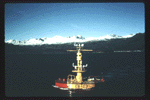
Climate Resources

|
NCDC | Contents | Satellite | Climate | Radar | Search | Help
Resources | Get/View Data | Products | Inventories | Research
 About NCDC's Climate Resources
About NCDC's Climate Resources
 Introduction
Introduction
- Many types of environmental or weather observations can be termed climate resources. These observations can be weather land surface observations, ocean (marine) atmospheric observations, weather upper atmospheric observations, weather radar observations, weather satellite observations (images or data). This section of the National Climatic Data Center web pages concentrates on the surface and upper air observations and products generated from these observations.
 Surface
Surface
 Surface land observations contain various meteorological elements that over time can describe the nature of the climate of a location or region. These elements include temperature, dew point, relative humidity, precipitation, snowfall, snow depth on ground, wind speed, wind direction, cloudiness, visibility, atmospheric pressure, evaporation, soil temperatures, and various types of weather occurrences such as hail, fog, thunder, glaze, etc. The weather observations are normally hourly observations (can be more frequent) and there are daily and monthly summaries. Many of the summaries are published on paper, electronically and via CD-ROM. Surface data from around the world are archived at NCDC.
Surface land observations contain various meteorological elements that over time can describe the nature of the climate of a location or region. These elements include temperature, dew point, relative humidity, precipitation, snowfall, snow depth on ground, wind speed, wind direction, cloudiness, visibility, atmospheric pressure, evaporation, soil temperatures, and various types of weather occurrences such as hail, fog, thunder, glaze, etc. The weather observations are normally hourly observations (can be more frequent) and there are daily and monthly summaries. Many of the summaries are published on paper, electronically and via CD-ROM. Surface data from around the world are archived at NCDC.
 Marine
Marine
 Surface Marine observations contain various meteorological elements that over time can describe the nature of the climate of a location or region. These elements include temperature, dew point, relative humidity, precipitation, snowfall, snow depth on ground, wind speed, wind direction, cloudiness, visibility, atmospheric pressure, evaporation, soil temperatures, and various types of weather occurrences such as hail, fog, thunder, glaze, etc. NCDC receives and archives meteorological data from ships at sea as well as buoys both fixed and free floating. The weather observations are normally hourly observations (can be more frequent) and there are daily and monthly summaries. Many of the summaries are published on paper, electronically and via CD-ROM. Surface Marine data from around the world are archived at NCDC.
Surface Marine observations contain various meteorological elements that over time can describe the nature of the climate of a location or region. These elements include temperature, dew point, relative humidity, precipitation, snowfall, snow depth on ground, wind speed, wind direction, cloudiness, visibility, atmospheric pressure, evaporation, soil temperatures, and various types of weather occurrences such as hail, fog, thunder, glaze, etc. NCDC receives and archives meteorological data from ships at sea as well as buoys both fixed and free floating. The weather observations are normally hourly observations (can be more frequent) and there are daily and monthly summaries. Many of the summaries are published on paper, electronically and via CD-ROM. Surface Marine data from around the world are archived at NCDC.
 Upper Air
Upper Air
 Weather data from the atmosphere above the earth's surface (greater than 3 meters to 1000s of meters above the surface) are also stored at NCDC. This data is obtained from instrument packages (radiosondes, rawinsondes, and rocketsones) that are carried aloft by weather balloons that transmit the data back to a receiving station on the ground. This "upper air" data consists of temperature, relative humidity, atmospheric pressure, and wind. Vertical profiles of atmopsheric measurements (atmospheric soundings) are available. Upper atmospheric data from around the world are archived at NCDC.
Weather data from the atmosphere above the earth's surface (greater than 3 meters to 1000s of meters above the surface) are also stored at NCDC. This data is obtained from instrument packages (radiosondes, rawinsondes, and rocketsones) that are carried aloft by weather balloons that transmit the data back to a receiving station on the ground. This "upper air" data consists of temperature, relative humidity, atmospheric pressure, and wind. Vertical profiles of atmopsheric measurements (atmospheric soundings) are available. Upper atmospheric data from around the world are archived at NCDC.
 Top of Page
Top of Page
http://www.ncdc.noaa.gov/oa/climate/climateresources.html
Downloaded Saturday, 16-Oct-2004 07:04:45 EDT
Last Updated Wednesday, 23-Jun-2004 07:35:08 EDT by ncdc.webmaster@noaa.gov
Please see the NCDC Contact Page if you have questions or comments.